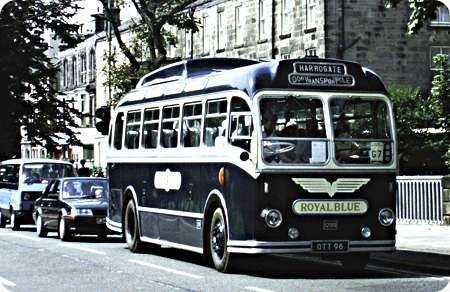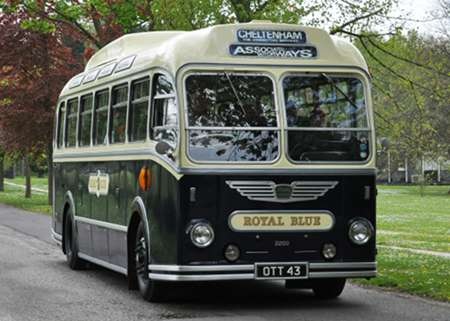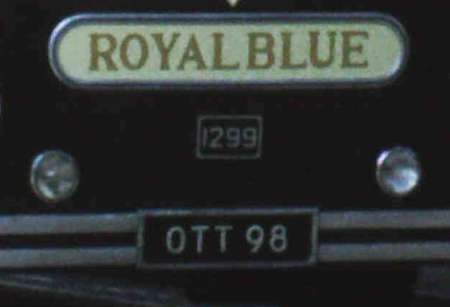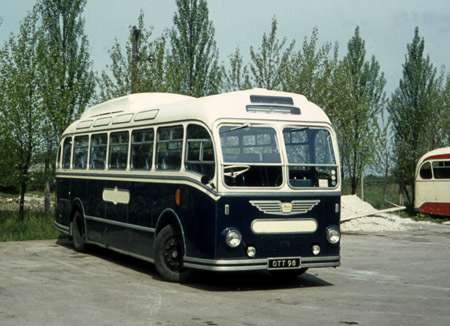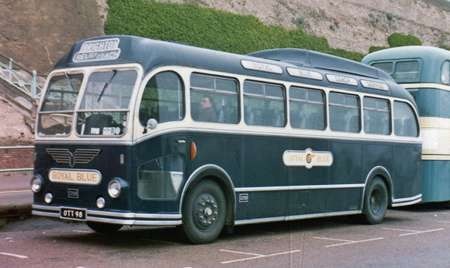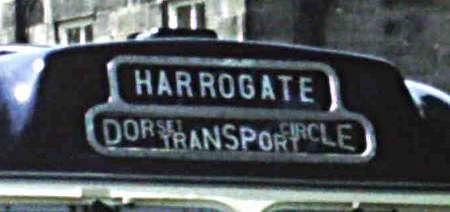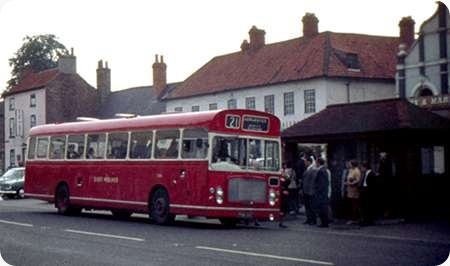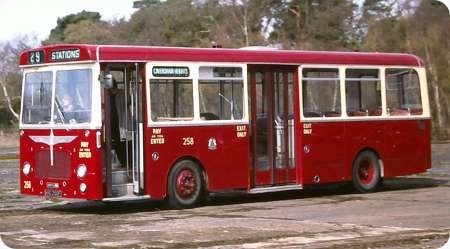Southern National – Bristol LS – OTT 98 – 1299
Southern National Omnibus Company
1953
Bristol LS6G
ECW C41F
Seen heading along York Place, Harrogate at the end of a Trans-Pennine run is Southern National 1299 (OTT 98), a 1953 Bristol LS6G with ECW C41F coachwork. Resplendent in iconic Royal Blue livery, this coach was part of the last batch to be built with the traditional Royal Blue roof-mounted luggage rack, which was accessed by a set of foldaway steps at the rear of the vehicle. It is a fine example of the underfloor-engined Royal Blue fleet operational in the 1950’s and 1960’s, and it is good to see 1299 wearing its original ‘dark roof’ version of the livery once again. (In 1958, with the arrival of the MW coaches, the livery was altered to a half blue/half cream layout, with dark blue up to waist rail level, and cream above). The 1953 batch of coaches for operation on Royal Blue services were also the last to display ‘Royal Blue Coach Service’ illuminated panels above the side windows. Subsequent deliveries of LS and MW coaches sported the more usual curved roof glasses in the cant rail panels instead.
Photograph and Copy contributed by Brendan Smith
12/01/14 – 07:47
Despite the registration there was nothing OTT about this. Rather understated luxury and quality with the 6LW offering a long legged, relaxed, lope in the pre motorway era.
David Oldfield
12/01/14 – 11:12
Thanks for posting, Brendan. I have read in different places of the shape caused by the presence of the rooftop luggage rack as being "Camel Back". Rather flattering to a camel, perhaps!
Pete Davies
12/01/14 – 13:04
There was always something special about Royal Blue coaches and these last-gasp versions of the traditional style are no exception. One point, were the roof racks ever used?
Chris Hebbron
13/01/14 – 08:44
I thought you might like to add this picture to the current OTT 98 thread as it shows a similar preserved vehicle but in the cream roof colours.
Ken Jones
13/01/14 – 08:44
The roof luggage carriers were used – I have a copy of a picture (not my copyright though!) of the driver loading luggage on LS car 1292 – in the ‘cream roof’ era, so post 1958.
The reason for the livery change was not ‘cosmetic’ but a practical one – I will look out the exact details in next day or two !
Peter Delaney
13/01/14 – 09:46
I’m wondering whether this is 1297, OTT 96. Both 1297 and 1299 are preserved but 1297 went to the Netherlands at some stage.
Geoff Kerr
Close up of registration and fleet number of posted shot.
13/01/14 – 11:25
I thought this photo may be of interest. It is OTT 98 after sale to the dealer W. North, Sherburn-in-Elmet, seen at their premises during the Summer of 1970.
It was quite a shock to see this here, as I had shortly before been on holiday in North Devon and seen these LS’s still working hard for a living. It was still in splendid condition here and I remember hoping that it would find a suitable. sympathetic new owner. At the time it seemed far too modern to be considered for preservation. Fortunately OTT 96 is still with us.
John Stringer
13/01/14 – 13:45
Thanks – it does look a bit like 96 though!
Geoff Kerr
I must admit I did have to go back to the original shot to be sure.
13/01/14 – 15:17
Both 1297 (OTT 96) and 1299 (OTT 98) are still with us. The former is in The Netherlands as part of the Leek collection at Monickendam, and OTT 98 is now part of the West Country Historic Omnibus and Transport Trust collection, having had a complete engine rebuild in 2007 and was hand painted back into original 1953 livery in 2009. I am delighted to be 1299’s current custodian and sponsor.
I look forward to reading Peter’s explanation as to the reasons for the change in roof colour in 1957.
Incidentally all this 1953 batch, 1293-9 and 2200-2, were down-seated to C39F following mid-life refurbishment at ECW Lowestoft, in 1961, and 1299 remains so.
John Grigg
13/01/14 – 16:42
Just a reminder you can see a picture of OTT 98 and one of OTT 43 from 2012 on this site at the Royal Blue Run gallery.
Ken Jones
13/01/14 – 17:40
I attach a photo of 1299 taken in the early 70’s which was taken on Madeira Drive Brighton following a HCVC London-Brighton run. This shows it with a blue roof as it is now preserved so it seems that the roof has changed colour a number of times over the years, I agree that the blue roof looks better but this is purely a personal preference I know.
Diesel Dave
14/01/14 – 08:22
The ‘incident’ which led to the change in colour of the roof of Royal Blue cars was as below:-
On August 2nd 1957, the 2.35 pm summer only service from Plymouth to Bournemouth, was a Bristol L coach – probably car 1239 – being driven John Whitlock when its roof was grazed by a plane landing at Exeter Airport. The undercarriage hit the top of the coach, breaking both skylights. He drove to the control tower, with the somewhat shaken passengers on board, and reported the incident. The pilot apparently had not seen a coach, and following his reporting the incident, there was an official enquiry, which John was asked to attend.
The incident was reported in the local Exeter newspaper, the ‘Express and Echo’, on 3rd August 1957, under the heading "Bus roof ‘skimmed’ by plane" and "Observers ‘saw nothing unusual’". From the newspaper account we learn that the coach was going along the Exeter – Honiton road, when the roof was "’skimmed’ by a twin engined Mosquito going in to land at Exeter Airport. The plane landed without a mark on it and the coach had a slight dent in the roof. The bus driver felt a slight bump. As there were no other cars on the road at the time he assumed it must have something to do with a plane that had passed low over him. Wing Cmdr. R J B Pearse, manager of the airport, said that a slight dent was found in the roof of the bus, but when an inspection was made of the Mosquito there was not a mark to be found, either on the tyres or the paintwork. The pilot said he had felt nothing at all. ‘We can only assume that the plane did touch the bus’ said Wing Cmdr Pearse. The pilot’s name was withheld".
The subsequent enquiry resulted in an accident report card being filed with the RAF, and that adds further information. The aircraft was a Mosquito Mk 35, number TA724, of the 3/4 CAACU, part of 61 Group, Home Command. The accident occurred at 16.55 on 2nd August 1957, at the end of a 2 hour 10 minute flight out and back from Exeter. This particular flight had been for Army firing practice. The pilot, 35 year old Flt Lt K Munson, was experienced, with 195 flying hours on Mosquitos, and 1567 flying hours overall. The lighting conditions were described as ‘dull’. At the end of the exercise, the pilot had joined the circuit and landed, but he was totally "unaware that his aircraft had struck the single decker bus (sic) travelling on the A30 road which runs adjacent to the airport". The report also records that "damage was caused to the roof of the bus. No damage was sustained to the aircraft."
It was considered that the organisation ‘at station level’ was at fault, as they knew of the danger of a collision between aircraft and vehicles, but had "made inadequate efforts to have remedial action taken." The A30 passed across the approach to runway 13, at a distance of 50 yards. There were no traffic signals or warning notices on the road, and there was a tall hedge bounding the road which "would effectively prevent the pilot seeing the bus and vice versa". No blame was attached to the pilot (who was making a low approach in order to touch down early on a short runway) or the driver.
As a result, 150 yards of the runway 13/31 were ‘sterilized’, and a local flying order issued to warn pilots of the dangers likely to be met on the approach to runway 13, whilst the roof of Royal Blue coaches was changed from dark blue to cream, to make them more conspicuous from the air.
Peter Delaney
14/01/14 – 11:48
I’ve just checked my original his-res image, and it definitely is OTT 98, confirmed by my notes taken at the time I wasn’t aware that it was also preserved – that’s nice to know.
John Stringer
14/01/14 – 12:27
The give away in the photo that it can only be OTT 98 is that the words "Dorset Transport Circle" are shown in the "via" part of the destination display. DTC owned this coach for well over 30 years and rallied it extensively for most of that time before generously donating it to WHOTT in 2006.
John Grigg
Quick links to the - Comments Page - Contact Page - Home Page
